

MLA Formatting and Style Guide. Summary: MLA (Modern Language Association) style is most commonly used to write papers and cite sources within the liberal arts and humanities.

This resource, updated to reflect the MLA Handbook for Writers of Research Papers (7th ed.) and the MLA Style Manual and Guide to Scholarly Publishing (3rd ed.), offers examples for the general format of MLA research papers, in-text citations, endnotes/footnotes, and the Works Cited page. Contributors:Tony Russell, Allen Brizee, Elizabeth Angeli, Russell Keck, Joshua M. Paiz, Michelle Campbell, Rodrigo Rodríguez-Fuentes, Daniel P. Kenzie, Purdue OWL StaffLast Edited: 2013-02-14 10:32:55 This handout provides an example of a Works Cited page in MLA 2009 format.
Works Cited "Blueprint Lays Out Clear Path for Climate Action. " Clinton, Bill. Hawaii State Public Library System. PragerU - Journal. September 11 2001 As It Happened - CNN Live 8.40am - 10.11am. Educational Resources - World Savvy. "[World Savvy] helped me locate resources, develop curriculum, and create interesting student projects.
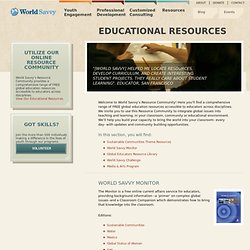
They really care about student learning". Educator, San Francisco Welcome to World Savvy’s Resource Community! Here you’ll find a comprehensive range of FREE global education resources accessible to educators across disciplines. We invite you to use this Resource Community to integrate global issues into teaching and learning, in your classroom, community or educational environment. In this section, you will find: The Monitor is a free online current affairs service for educators, providing background information –a ‘primer’ on complex global issues–and a Classroom Companion which demonstrates how to bring that knowledge into the classroom. Editions: Search the Resource Library The World Savvy Challenge is an academic program for middle and high school students to build their knowledge, skills, attitudes and behaviors for global competence. Program Resources: General Program Information. For Educators. Social Studies, Government, and Geography.
Facing History and Ourselves - Vidéos - Google+ 101 Social Studies Websites for Teachers - U.S. History, World History. Cornell Notes. You can use the Cornell Notes note-taking method to take better notes in any class.
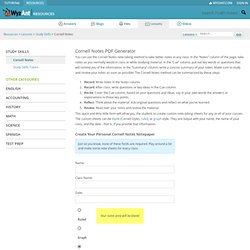
In the “Notes” column of the page, take notes as you normally would in class or while studying material. In the “Cue” column, pull out key words or questions that will remind you of the information. In the “Summary” column, write a concise summary of your notes. Make sure to study and review your notes as soon as possible!
The Cornell Notes method can be summarized by these steps: Record: Write notes in the Notes column. Stock.xchng - the leading free stock photography site. Remembering 9/11 With Indelible Pictures. Piktochart : Make Information Beautiful - Themes. UH - Digital History. 5 Must Have Resources for History Teachers. August 15, 2014 Below is a set of excellent websites ideal for history teachers.
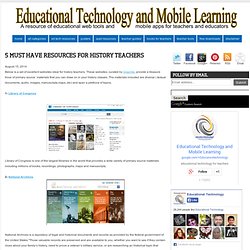
These websites, curated by Graphite, provide a treasure trove of primary source materials that you can draw on in your history classes. The materials included are diverse ( textual documents, audio, images, manuscripts,maps..etc) and span a plethora of topics. 1- Library of Congress Library of Congress is one of the largest libraries in the world that provides a wide variety of primary source materials including millions of books, recordings, photographs, maps and manuscripts. 2- National Archives National Archives is a repository of legal and historical documents and records as provided by the federal government of the United States.
" 3- Digital Public Library of America 4- Docs Teach Docs Teach provides thousands of primary source documents that span the course of American history. to bring the past to life as classroom teaching tools from the billions preserved at the National Archives. U.S. Department of State. A Collection of the Best Google Maps Street View Imagery. Teach with Movies! It's a fact: when you teach with movies, you offer your class a welcome break to traditional teaching methods.
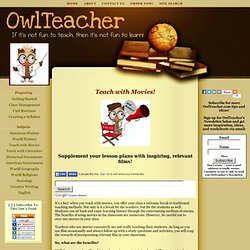
Not only is it a break for the teachers, but for the students as well. Students can sit back and enjoy learning history through the entertaining medium of cinema. The benefits of using movies in the classroom are numerous. However, be careful not to over-use movies in your class. Teachers who use movies excessively are not really teaching their students. So, what are the benefits? Well, for one, movies offer a history lesson in an entertaining format. So which movies do you use and how do you teach with them? First, you must take into consideration which movies you will use. You must also keep in mind that students will get caught up in the story and disregard the details that relate to the history or the lesson.
Another important point is that using movies in the classroom is not an opportunity for either the students or the teacher to goof off. Search Alphabetically: Teach World History! Custom Search Learning about and understanding World History is crucial for a plethora of reasons.
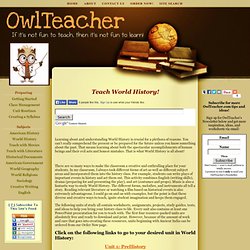
You can’t really comprehend the present or be prepared for the future unless you know something about the past. That means learning about both the spectacular accomplishments of human beings and their evil acts and honest mistakes. That is what World History is all about! There are so many ways to make the classroom a creative and enthralling place for your students. Original Historical Documents.